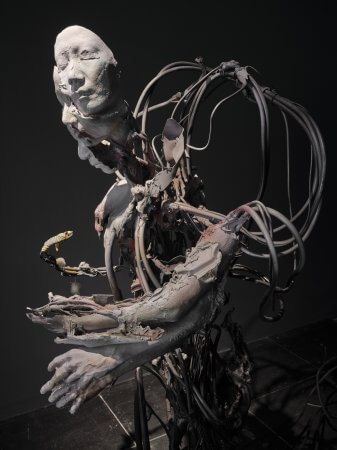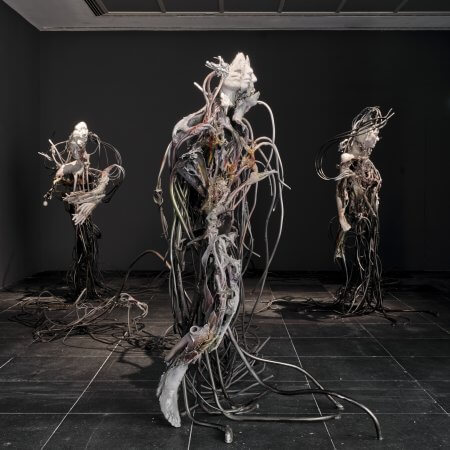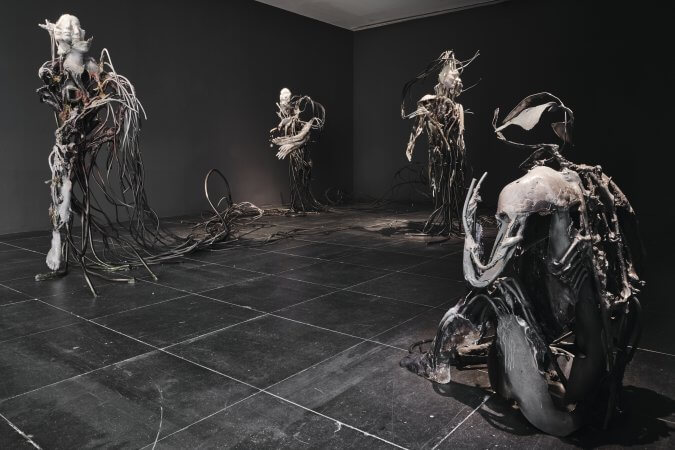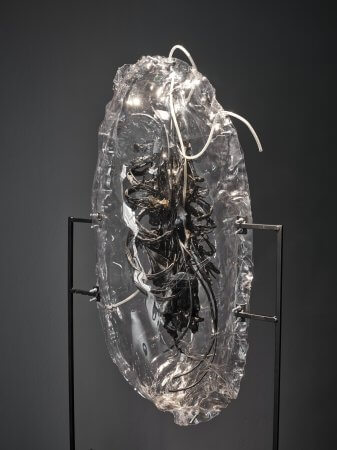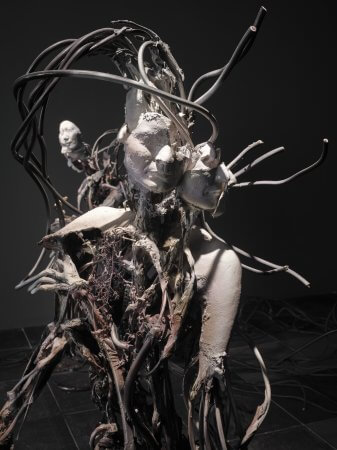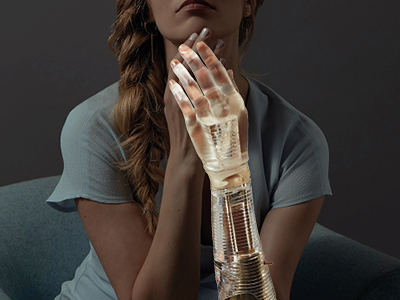Yein Lee
System of In-between State, 2024
Three sculptures
Steel, polymer gypsum, epoxy putty, branches, dry grape stalk, broken vacuum cleaner, electrical cables, fibreglass, acrylic ink, lacquer
125 x 110 x 186 cm; 100 x 110 x 175 cm; 84 x 88 x 174 cm
Commissioned by the 15th Gwangju Biennale and sponsored by the Austrian Ministry of the Arts, Culture, the Civil service and Sport
in other’s shoes – maybe no need for shoes, 2022
Sculpture
Epoxy putty, motorbike parts, electrical wires, fake flower, Polymer gypsum, steel, plaster
79 x 65 x 110 cm
Interlock Vertebra Devices, 2021
Sculpture
3D print, epoxy putty, wire, computer parts, spray, earring, cables, cable ties, motorbike part, PET sheet, hardware, tube
45 x 68 x 160 cm
Courtesy the artist
Yein Lee challenges the notion of the body as flawless, intact and always functional. Her sculptures take the form of anthropomorphic, life-sized figures that, stripped of their outer shells, reveal their inner structures. Lee constructs her works from electrical cables, steel pipes, computer parts, but also from branches, twigs and found everyday objects. Her material is at once synthetic and natural. It comes from industrial production, from the remnants of our digitally networked society and from nature.
Lee’s sculptures embody the contradictions of their origins—between handcraft and short-lived disposable objects, destined for material decay. Rather than resolving these oppositions, Lee makes them visible. Her works exist in an in-between state—oscillating between human and machine, the living and inert matter, organic growth and decay.
Born and raised in South Korea, Yein Lee has lived and worked in Vienna for several years. Her work draws on influences from classical sculpture, science fiction and cyberculture. She is fascinated by Medardo Rosso’s fragile wax figures and by the Baroque sculptures of Gian Lorenzo Bernini, who created the illusion of living bodies in marble. Lee is also drawn to figures from myth and literature that embody the idea of transformation as hybrid beings: Daphne’s metamorphosis, in Greek mythology, as she escapes Apollo’s assault by turning her female body into a tree; or the boy Namu Doryeong from the Korean founding myth, son of a celestial fairy and an earthly tree, who survives the great flood and from whom humankind descends.
Yein Lee explores the similarities of internal structures across organisms: from the network of human blood vessels, nerves, muscles and tendons to the branches and roots of plants. Her figures are made of permeable fibres that merge and break apart, grow in rhizome-like patterns and send out extensions in search of support in space. Lee conceives of the body not as a closed form. From these clusters she gives her figures multiple faces, cast from herself and from people close to her.
They reflect a world in which the boundaries between human and machine, nature and technology, self and other are increasingly dissolving. In this in-between realm, the body no longer appears as a stable centre but as an unstable interface, in a state of constant transformation.
At the centre of her reflections lies the impossibility of conceiving the body as a static entity. The body is transformation, extension and reconstruction, and at the same time, it is fragile. Yein Lee shares this experience from her own medical history: implants were anchored in her body, which healed and now support her. Her body has grown together with the metal of the screws—like a tree whose bark encloses an object that stood in its way. The body as an amalgam of the organic and the artificial, as a new normality—that is life.
Yein Lee’s work is permeated by the ideas of cyberpunk aesthetics: bodies appear extended, damaged, fragmented, shot through with cables and apparatuses. Lee presents fragile, precarious existences that linger in an in-between state. Transformation, metamorphosis and openness are not transitions but conditions, in which her sculptural beings continually reassemble themselves anew.
In the work Interlock Vertebra Devices, speculative implants for body enhancement appear packaged in plastic like fast-moving consumer goods. The desire for improvement, youth and functionality comes to the fore: the human being as driven by the pursuit of a better physical self.
Her works are pleas for a new corporeality: vulnerable, processual and beyond normative attributions. At a time when optimisation has become a trend, and technology a prosthesis and an extension of the body, Lee’s sculptures open up a field of possibilities: for other bodies, other futures, other forms of being.
Yein Lee (*1988 Incheon, KOR) is a South Korean artist currently living in Vienna (AT) who works in the fields of installation, sculpture, painting and performance. After completing her bachelor’s degree in traditional Asian painting at Hongik University in Seoul (KOR), Lee earned a master’s degree at the Academy of Fine Arts in Vienna (AT). Her work has been shown internationally in group exhibitions at the 15th Gwangju Biennale (KOR), the Centre d’Art La Meute in Lausanne (CH), the Château – Centre d’Art Contemporain de la Ville d’Aubenas (FR), the Centre Culturel Suisse in Paris (FR), Belvedere 21 in Vienna (AT), Kunstraum Niederösterreich in Vienna (AT). 2025 the Galerie Bremond Capela in Paris (FR) dedicated Lee a solo show.

